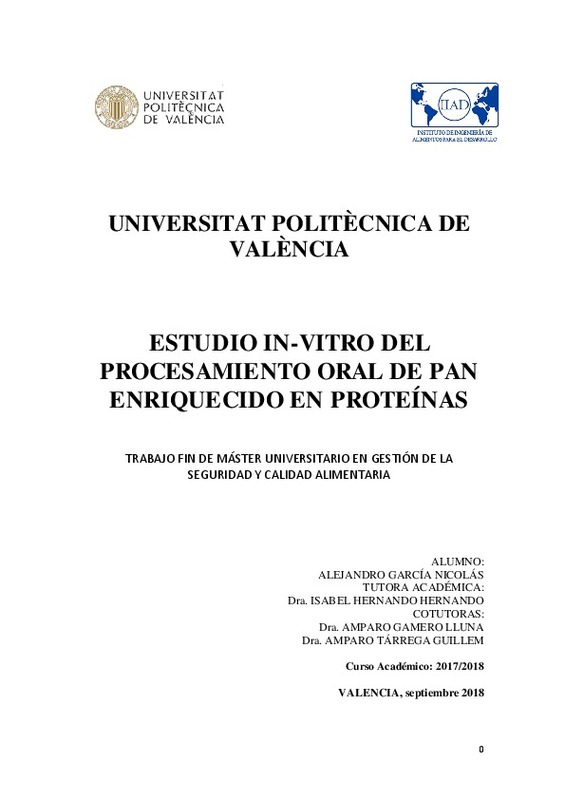|
Resumen:
|
[ES] En este estudio se evaluó la textura y el procesado oral in-vitro de pan
enriquecido con proteína de guisante. Se elaboraron ocho panes enriquecidos
con proteína de guisante que variaron en la concentración de ...[+]
[ES] En este estudio se evaluó la textura y el procesado oral in-vitro de pan
enriquecido con proteína de guisante. Se elaboraron ocho panes enriquecidos
con proteína de guisante que variaron en la concentración de proteína (2,5%
y 5%), su tamaño de partícula (<45 µm y >45 µm) y el grado de hidratación de
la masa. Se determinaron las variaciones en los parámetros de textura de los
panes y se analizaron las características de la miga mediante análisis de
imagen. Asimismo, se estudió in-vitro el grado de rotura de la estructura del
pan, la hidrólisis de almidón y liberación de sal mediante la determinación de
la glucosa y la sal liberada mediante espectrofotometría y refractometría,
respectivamente. Los resultados mostraron que la adición de proteína de
guisante incrementa los valores de dureza y masticabilidad, y presentaron una
miga con mayor número de alveolos de menor tamaño. Estos efectos
dependieron de la cantidad de proteína y del grado de hidratación, de forma
que los panes con 2,5% de proteína y con hidratación ajustada fueron los que
más se asemejaron al control. En la masticación in-vitro, los panes con mayor
concentración de proteína (5%), presentaron mayor grado de fragmentación
con más partículas de menor tamaño. Sin embargo, no se observó que estos
cambios en la estructura y textura del pan afectaran a la hidrólisis de almidón
y a la liberación de sal.
[-]
[EN] In this study was evaluated the texture and in-vitro oral processing of bread
enriched with pea protein. We made eight breads enriched with pea protein
that varied in protein concentration (2,5% and 5%), their ...[+]
[EN] In this study was evaluated the texture and in-vitro oral processing of bread
enriched with pea protein. We made eight breads enriched with pea protein
that varied in protein concentration (2,5% and 5%), their particles size (<45 µm
and >45 µm) and the degree of hydration of the dough. The variations in the
texture parameters of the loaves were determined and the characteristics of
the crumb were analyzed image analysis. Also, the degree of breakage of
bread structure, starch hydrolysis and salt release was studied in-vitro by
determining glucose and salt released by spectrophotometry and
refractometry, respectively. The results showed that the addition of pea protein
increases the values of hardness and chewiness, and presented a crumb with
a greater number of cells and smaller of size. These effects depended on the
amount of protein and the degree of hydration, so that the loaves with 2,5%
protein and with adjusted hydration were the ones that most resembled the
control. In the in-vitro mastication, the loaves with the highest protein
concentration (5%) showed a higher degree of fragmentation and more
particles of smaller size. However, it was not observed that these changes in
bread structure and texture affected the hydrolysis of starch and the release
of salt.
[-]
|







